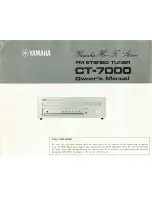
6
11
INSTALLATION EXAMPLE
2001 NEW
2001 NEW
11
2001 NEW
2001 NEW
The following are antenna tuner and antenna installa-
tion examples for a non-sail boat.
They also explain both transmission and reception
performance, for your reference.
•
Descriptions
Antenna
tuner
Vertical
element
Horizontal element
Antenna tuner location versus the strength of radiation from the antenna element
D
The antenna tuner should be installed outside the vessel as high as possible.
However, the length of the vertical element should also be as long as possible.
Good — High position
This antenna tuner unit position is bet-
ter than others but the length of the ver-
tical element is shorter than the others.
Better — Mid position
This installation is also good.
Best — Low position
This installation is perfect for the length
of the vertical element and the total ele-
ment length.
Style of the antenna element
D
When the horizontal element is longer, or made with multiple wires, the effective height of the antenna is high and
communication distance may be improved.
Good
—
Vertical
This is a basic style with only the verti-
cal element. This style is not effective
for NVIS* communications.
Better
—
Inverted-L
This style is a good for NVIS* and lon-
ger communications.
Best
—
Two wire inverted-L
This is an even better element style
than the one to the left.
* Near Vertical Incidence Skywave. This is a radio-wave propagation method that provides usable signals in the range between
groundwave and skywave distances (usually 30 to 400 miles, or 50 to 650 km).
Good
—
Vertical
This is a good style. The vertical ele-
ment radiates waves, but the length of
the element may not be enough for HF
low band operation.
Better
—
Type-T
The antenna effective height is much
better than other styles. The higher
position of the Antenna tuner provides
longer communication distance.
Best
—
Inverted-L
This is the best style for HF low band
operation as the vertical element is
long, and the total element length is
also long.
Antenna element style versus the strength of radiation from the antenna element
D
When the antenna tuner is installed on the deck, the following installation may be possible. The antenna element
should be as long as possible, especially for the HF low band, such as the 8 MHz marine band.
R
DANGER: HIGH VOLTAGE!
NEVER
touch the antenna element while tuning or
transmitting.

































